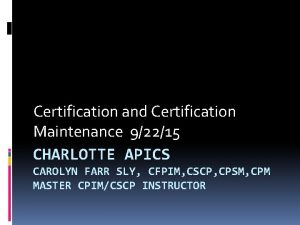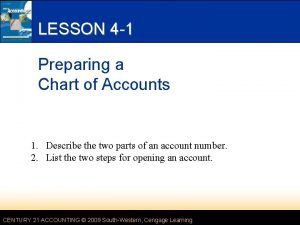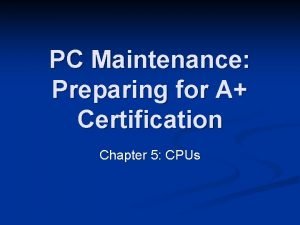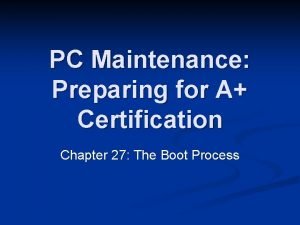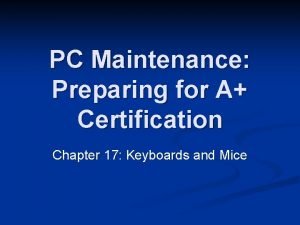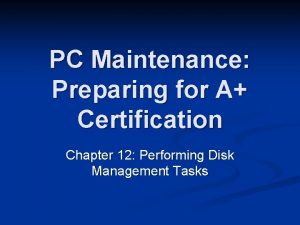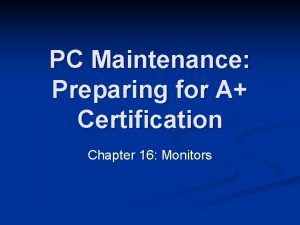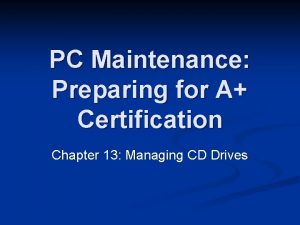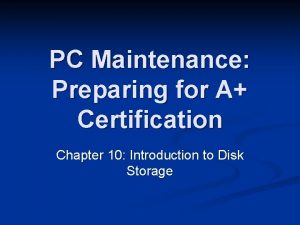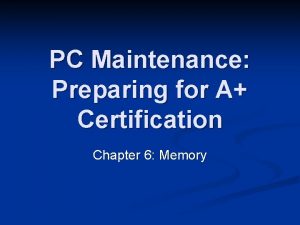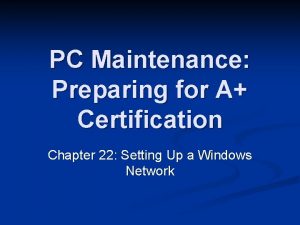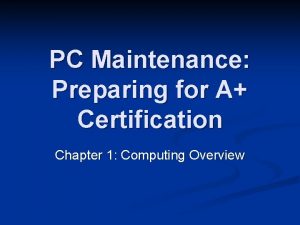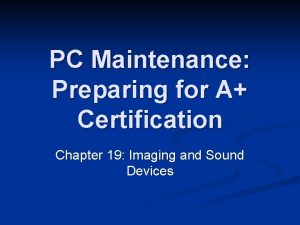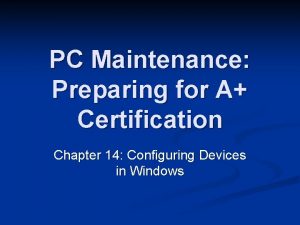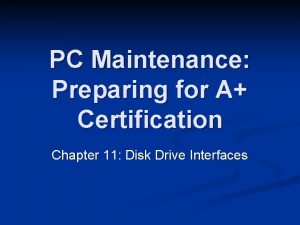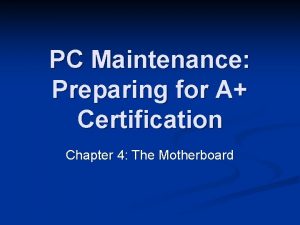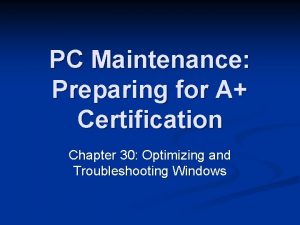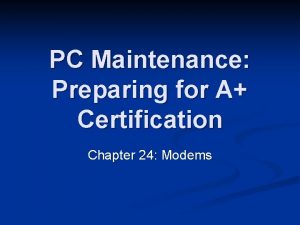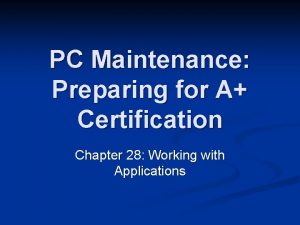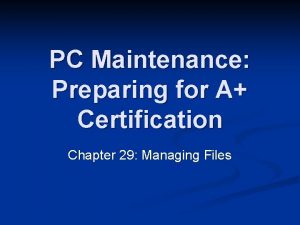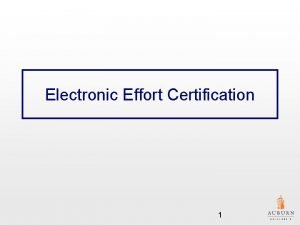PC Maintenance Preparing for A Certification Chapter 21


































- Slides: 34

PC Maintenance: Preparing for A+ Certification Chapter 21: Networking Hardware Concepts

Chapter 21 Objectives Identify networking topologies n List common wired networking standards n List common wireless networking standards n Describe hardware needed to create a network n

Resources Shared on a Network Hard disk space n Disk drives (CD-ROM, ZIP) n Printer access n Internet access n DSL/Cable Router n Internet Connection Sharing n

LAN versus WAN n Local Area Network (LAN) n n Confined to a small area such as a building Wide Area Network (WAN) n Networking on a much larger geographical scale (ex. the Internet)

Client/Server Networking Client: Enduser PC or device n Client/Server: Network that contains both clients and servers Server: PC that exists to provide network services

Peer to Peer Networking All clients (no servers) n All PCs share networking burden n No server software needed n Works well for very small networks (under 10 computers) n Becomes cumbersome with larger numbers n

Physical Topologies Bus n Ring n Star n Mesh n

Bus Topology No longer widely used. 10 Base 2 and 10 Base 5 were examples.

Ring Topology Older; no longer commonly used as a physical arrangement

Star Topology Most common physical topology in use today

Mesh Topology Physical topology used on the Internet

Hybrids n n Most networks of medium or large size use a combination of physical topologies A star-bus combination is shown here

Logical Topologies n Logical refers to the way information is passed on the network n For example, if the physical topology represents the streets in a town, the logical topology would represent the mail carrier’s route Logical topologies: star, ring, bus n Logical topology need not match the physical topology n

Ethernet Most popular networking standard n Logically a bus n Physically a star, ring, or hybrid n Can be wired or wireless n Can use copper wire or fiber optic cable n

Some Ethernet Types 1000 Base. T (Gigabit Ethernet) n 100 Base. T (Fast Ethernet) n 10 Base. T, 10 Mbps n 10 Base-2 (Thinnet) n 10 Base-5 (Thicknet) n Wireless Ethernet n n n 802. 11 a, 802. 11 b, 802. 11 g 10 Base. FL, 10 Base. FX

Collision Avoidance in Ethernet Carrier Sense Multiple Access/Collision Detection (CSMA/CD) n Collision detected and retry occurs at random time n

Wireless Ethernet Also called Wi-Fi n 802. 11 b: up to 11 Mbps, very popular, range of 250 to 300 feet n 802. 11 g: up to 54 Mbps, backwardcompatible with 802. 11 b n 802. 11 a: up to 54 Mbps, not compatible with 802. 11 b n

Token Ring Networking n n Physically a star: Multistation Access Unit (MSAU) Logically a ring

Collision Avoidance in Token Ring n Only the PC with the token can send data

Token Passing

FDDI Network – Dual Ring

Data Packets Packet contains data plus header and footer n Header specifies destination and protocols used n Footer contains error-checking information n

OSI Layers Open Systems Interconnection n Reference model for discussing networking n Explains how a network operates n Helps when troubleshooting network problems n

OSI Layers

Network Protocols Protocol: An agreed-upon language for transmitting data between devices n Example: TCP/IP n TCP operates at Transport level n IP operates at Network level n n Example: FTP n Operates at Presentation and Application level

Network Interface Card (NIC) n Choose correct model for network type n Ethernet n Wired (10/100 Base. T, 1000 Base. T) n Wireless (802. 11 a, b, g) n n Token Ring Choose correct model for bus to be used PCI n ISA n USB n

MAC Address Hard-coded address in NIC n 6 -byte hexadecimal number n No two in the world have the same MAC n First three bytes indicate manufacturer n Second three bytes are ID number n

Connecting Devices Hubs n Switches n Multi-Station Access Units (MSAUs) n Routers n Bridges n

Hub n n n A physical gathering point for cables from NICs Dumb, does not evaluate addressing Sends same message to all connected nodes Speed to each node decreases with each node connected Wireless models are called “Access Points”

Switch A smart version of a hub n Evaluates addressing and sends packets only to addressee n Attaching more nodes does not split speed n Replacing hubs in popularity because of superior performance n

Multi-Station Access Unit Used in Token Ring networking n Physically looks like a hub or switch n Logically conducts packets in a ring n

Router Reads IP addresses n Routes packets between subnetworks n Physically looks like a hub or switch n Allows home users to share cable or DSL Internet n Routers used extensively on Internet n Both wired and wireless models available n

Bridges and Gateways n Bridge: Connector between two physically dissimilar networks Wired Ethernet to wireless Ethernet n Phone line Ethernet to 100 Base. T Ethernet n n Gateway: Connector between two logically dissimilar networks Token ring to Ethernet n Ethernet to Apple network n

Wireless Networking Hardware Similar to wired equivalents n Standards n 802. 11 a n 802. 11 b n 802. 11 g n n Security is an issue n Wired Equivalent Privacy (WEP)
 Apics maintenance points
Apics maintenance points Test chapter 18 preparing for the world of work
Test chapter 18 preparing for the world of work Chapter 17:4 participating in a job interview
Chapter 17:4 participating in a job interview Chapter 18 preparing for the world of work
Chapter 18 preparing for the world of work Chapter 15 preparing for careers
Chapter 15 preparing for careers Part two—preparing a chart of accounts
Part two—preparing a chart of accounts Chapter 1 preparing your path to success
Chapter 1 preparing your path to success A place where you may obtain employment milady
A place where you may obtain employment milady Marketing essentials meaning
Marketing essentials meaning Kontinuitetshantering
Kontinuitetshantering Typiska novell drag
Typiska novell drag Tack för att ni lyssnade bild
Tack för att ni lyssnade bild Ekologiskt fotavtryck
Ekologiskt fotavtryck Varför kallas perioden 1918-1939 för mellankrigstiden?
Varför kallas perioden 1918-1939 för mellankrigstiden? En lathund för arbete med kontinuitetshantering
En lathund för arbete med kontinuitetshantering Underlag för särskild löneskatt på pensionskostnader
Underlag för särskild löneskatt på pensionskostnader Personlig tidbok fylla i
Personlig tidbok fylla i A gastrica
A gastrica Förklara densitet för barn
Förklara densitet för barn Datorkunskap för nybörjare
Datorkunskap för nybörjare Boverket ka
Boverket ka Debattartikel mall
Debattartikel mall För och nackdelar med firo
För och nackdelar med firo Nyckelkompetenser för livslångt lärande
Nyckelkompetenser för livslångt lärande Påbyggnader för flakfordon
Påbyggnader för flakfordon Tryck formel
Tryck formel Offentlig förvaltning
Offentlig förvaltning Jag har nigit för nymånens skära text
Jag har nigit för nymånens skära text Presentera för publik crossboss
Presentera för publik crossboss Teckenspråk minoritetsspråk argument
Teckenspråk minoritetsspråk argument Vem räknas som jude
Vem räknas som jude Klassificeringsstruktur för kommunala verksamheter
Klassificeringsstruktur för kommunala verksamheter Fimbrietratt
Fimbrietratt Claes martinsson
Claes martinsson Centrum för kunskap och säkerhet
Centrum för kunskap och säkerhet
